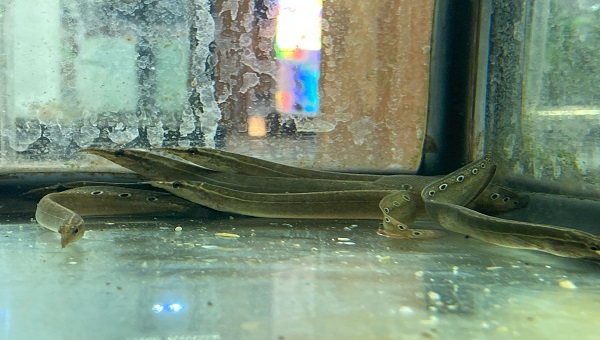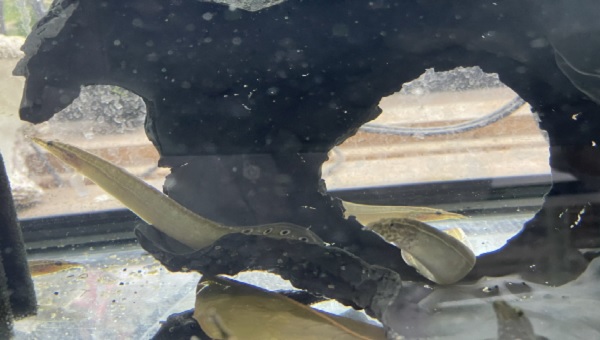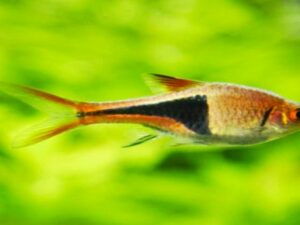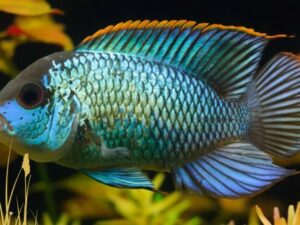Are you looking to add a unique, beautiful fish to your home aquarium? The peacock eel might be the perfect choice for you. Not only are they eye-catching, but they’re also relatively low-maintenance and can make great tank mates.
Learn all about Peacock Eel (Macrognathus siamensis) care, tank mates, food, size, and lifespan in this article, and find out if this amazing fish is right for your home aquarium.
Table of Contents
Peacock Eel: Species Summary
The Peacock Eel is a unique freshwater fish that originates in Southeast Asia. It is known for its elongated body and pointed snout, and its bright yellow stripes. Its lifespan and size can vary greatly depending on the environment it is kept in, but with proper care and diet, the peacock eel can live a long and healthy life.
| Common Name: | Peacock Eel, Spotfin Spiny Eel, Peacock Julie, and Painted Julie. | |
| Scientific Name: | Macrognathus siamensis | |
| Origin: | Asia (Cambodia, Laos, Malaysia, Peninsular Thailand) | |
| Size: | Up to 1.2 feet long | |
| Lifespan: | Maximum 18 years | |
| Tank size: | 30 gallons | |
| Water Temperature: | 76° to 82° Fahrenheit | |
| pH Range: | 6.5 to 7.5 | |
| Care Level: | Easy to Moderate | |
| Diet: | Omnivores |
Appearance and Characteristics
You’ll notice the peacock eel’s slim, elongated body with a pointed snout and separate dorsal, anal, and caudal fins. They usually range in color from tan to yellowish-green, with a line of brighter yellow running along their sides. Adding to their unique appearance, they possess eyespots towards the rear, giving off a mimicry-like effect.

Here are some other interesting characteristics:
- Colorful: Their yellowish-green color and yellow stripes make them stand out.
- Unique Fins: Unlike true eels, they’ve separate dorsal, anal, and caudal fins.
- Eyespots: Eyespots towards the rear give them a mimicry-like effect.
- Size: They typically grow to 12 inches, but can reach up to 18 inches in ideal conditions.
The peacock eel is an intriguing species with an unmistakable appearance. With the right care, they can enjoy a long and healthy life.
Origin and Distribution
You have a unique opportunity to own a species of freshwater fish native to Southeast Asia—the peacock eel. This species, also known as Macrognathus siamensis or Siamese spiny eel, can be found in near-stagnant bodies of water in Southeast Asia.
With its slim and elongated body, pointed snout, separate dorsal, anal, and caudal fins, and yellow line running laterally, it’s a sight to behold. Plus, its eyespots towards the rear make it a mimicry master.
Owning a peacock eel provides you with a sense of belonging to a unique species of fish and the opportunity to create a peaceful environment in which it can thrive.
Peacock Eel Lifespan
With proper care, your peacock eel can live between 8-18 years. This unique freshwater fish is a great addition to any home aquarium, and its lifespan can be extended with the right habitat and diet.
By maintaining pristine water conditions and providing a variety of high-protein foods, you can ensure that your peacock eel is healthy and happy. It’s also important to ensure that your tank size is large enough for your eel to roam freely. A 40 gallon tank is recommended; however, some success has been seen with tanks as small as 20 gallons. The larger the tank, the better.
Peacock Eel: Food and Diet
Feeding your peacock eel correctly is essential for a long and healthy life. To ensure good nutrition, feed them a diet similar to what they’d eat in the wild. To do this, provide a variety of foods like insect larvae, bloodworms, nightcrawlers, brine shrimp, and live, freeze-dried, and frozen meals.
Feed them twice a day in small portions to avoid overfeeding.
Diet and Nutrition in Captivity
Peacock eels are picky eaters and should be provided with a diet that closely resembles their natural diet in the wild. Insect larvae, bloodworms, nightcrawlers, brine shrimp, and live, freeze-dried, and frozen meals are all suitable food options. Feed them several small meals throughout the day, using tongs or tweezers to make sure the food is properly distributed.
As with any fish, water quality is key for nutrition and health. Monitor parameters and perform regular water changes to keep your eel healthy and thriving.
A varied diet is essential to ensure a balanced diet and to prevent nutrient deficiencies.
Feeding Frequency
You should feed your peacock eel two to three times a day. It’s important to give them small, frequent meals that they can finish within a few minutes. Avoid overfeeding as this can lead to health issues.
Feeding them a varied diet of live, freeze-dried, and frozen foods, as well as high-protein insect larvae, will ensure they get all the nutrients they need. Make sure to clean the tank and remove uneaten food to keep your eel healthy.
Feeding Methods
When it comes to feeding your peacock eel, you’ll need to provide them with small, frequent meals. Try offering them a variety of high-protein meals, such as bloodworms, nightcrawlers, brine shrimp, and insect larvae. Live, freeze-dried, and frozen food options are also suitable.
Feed them twice daily, and no more than they can consume within a few minutes. Keep in mind they can be picky eaters, so experiment with different options. Remember, proper nutrition is key to a long and healthy life for your peacock eel.
Peacock Eel: Behavior and Temperament
Knowing the behavior and temperament of peacock eels is important for successful care.
Peacock eels are generally peaceful, bottom-dwelling fish that like to hide from the light. However, they can become territorial when kept with other bottom-feeding fish, like loaches and catfish.

They thrive in a well-planted tank with plenty of hiding spots, and they’re generally shy and timid in an open tank.
Peacock eels are nocturnal, so they’re most active at night and will hide during the day. They’ll also bury themselves in the sand and become inactive, so it’s important to keep an eye on them.
They can be kept in groups, as long as the tank is large enough and there are plenty of hiding spots. Keeping them with other peaceful fish is also beneficial, as they’ll become less shy and more active when in the company of other fish.
Care Guide
Caring for your peacock eel isn’t as complicated as you may think. With the right tank size, water quality, and regular water changes, you can provide your fish with an optimal habitat.

Tank Size
The recommended tank size for your peacock eel is 40 gallons or more. This provides plenty of room for your fish to swim and explore. While some have found success with tanks as small as 20 gallons, larger tanks offer more swimming space and help your eel reach their full size.
Setting up an optimal habitat is key to keeping your eel healthy and long-lived. Make sure to create plenty of hiding spots in the tank for your eel to feel secure. A sand substrate is also ideal, as peacock eels are burrowers by nature.
Keeping your tank parameters within the desired range also helps your eel thrive. Aim for a water temperature of 73°F to 82°F, a pH of 6.5 to 7.5, and hardness of 6 to 25 DH.
With a spacious tank, regular monitoring, and correct parameters, your eel will be sure to live a long and happy life.
Water Quality
Ensuring the proper water quality is essential for your eel’s health and longevity. Aim for a temperature between 73°F to 82°F and pH levels of 6.5 to 7.5. Hardness should be between 6 to 25 DH.
Monitoring and maintaining these parameters is key to keeping your eel healthy. Additionally, regular water changes are important to maintain good water quality. This helps to keep nitrate levels low and helps to prevent the spread of disease.
With the right conditions, your peacock eel will have a healthy, long life. Make sure to keep a close eye on the water to ensure it’s clean and clear. Keeping a good balance will keep your eel happy and thriving for many years to come.
Water Changes
Regular water changes are necessary to maintain good water quality and keep your eel healthy. The rule of thumb is to change a third of the tank’s water every week. This helps keep ammonia and nitrate levels down and prevents the build-up of harmful bacteria.
Before performing a water change, test the tank’s water parameters to ensure it’s within the optimal range. Use a siphon to remove the dirty water and then add dechlorinated water to the tank. You can also use a water conditioner to help neutralize the chlorine in the tap water.
Make sure the new water has the same temperature and pH level as the existing water in the tank. Finally, keep in mind that peacock eels are sensitive to sudden changes in water chemistry. So, when performing a water change, do it gradually to help your fish adjust.
Water Conditioner
You need to make sure your peacock eel’s water is just right so they can thrive! Water conditioner is a must-have to help meet the water parameters. Here’s what you need to know:
- Use water conditioner when setting up the tank or doing water changes.
- Water conditioner helps neutralize chlorine and chloramines, as well as remove heavy metals and other contaminants.
- Water conditioner also helps buffer the water to the desired pH level.
- Water conditioner also helps create a healthy environment for beneficial bacteria.
It’s vital to use water conditioner regularly to keep your eel healthy and happy. Doing this will ensure they live a long and peaceful life.
Cleaning the Tank
To keep your peacock eel’s tank in tip-top shape, regularly clean it. This means removing waste, uneaten food, and detritus, as well as changing the water regularly.
To do this, use a gravel vacuum to suck up debris and waste. It’s best to do this weekly, or at least every two weeks depending on the tank size. Be sure to change out 10-15% of the water each time, and use a water conditioner to ensure the tank is safe for your fish.
If you’re cleaning the entire tank, be gentle with your fish by slowly acclimating them to new water. With regular care, you can provide your peacock eel with a safe and healthy home.
Gravel Vacuuming
Weekly gravel vacuuming is essential for keeping your fish’s habitat in ideal condition. It’s an important part of peacock eel care and a crucial part of keeping their tank clean.
You’ll need to use a gravel vacuum to remove debris from the tank’s substrate. Start at one end of the tank and slowly move the vacuum along the bottom, allowing it to suck up the dirt and debris. Make sure to move the vacuum slowly and gently so as not to disturb the eel or the tank decorations.
After vacuuming, make sure to rinse the gravel in a separate bucket before returning it to the tank to avoid any debris or chemicals being transferred back into the tank. It’s also important to replace the water that was removed during vacuuming.
Regular vacuuming will help keep your tank looking and feeling fresh and your peacock eel healthy and happy!
Algae Scraper
You should consider using an algae scraper in your peacock eel tank. Algae scraper tools are used to remove algae growth from aquariums. They can help keep your tank clean and prevent build-up of algae, which can harm your fish.
Make sure to use a scraper specifically made for aquariums and not one intended for other surfaces. Be careful to not scrape too hard, as it can damage the glass. You can also use a sponge or cloth to manually remove the algae as well.
Regularly cleaning the glass with an algae scraper will help keep your tank looking its best.
Sponge
In addition to an algae scraper, you can also use a soft sponge to manually remove any buildup of algae in your aquarium. It’s important to make sure you choose a safe sponge, as some may contain chemicals or materials that could be harmful to your fish. Look for sponges made specifically for aquarium use.
A soft sponge can be used to wipe down the glass, decorations, and other surfaces, to prevent the build up of algae. It’s also a great tool for cleaning up after water changes and other maintenance tasks.
To get the most use out of your sponge, rinse it out after every use and replace it every month or so. With the right care and maintenance, you can keep your aquarium free of algae and your fish healthy and happy.
Protein Skimmer
A protein skimmer is an effective device for removing organic contaminants from your tank water, promoting a healthier environment for your fish. It’s an aquarium filtration device that uses foam fractionation to separate proteins and other organic materials from the water. This helps to keep the water clean and clear, and reduces the amount of nitrates and other pollutants in the aquarium.
The device works by drawing in aquarium water and pushing it through a reaction chamber filled with air. This process causes the proteins and other organic materials to form a foam, which is then collected in the collection cup. Protein skimmers are relatively easy to set up and maintain, and are a great way to keep your tank clean and healthy.
They’re also a great way to help reduce the amount of work you’ve to do, as they can help to keep the water in your tank clean without you having to do much work. So, if you’re looking to keep your tank clean and healthy, consider investing in a protein skimmer.
Transportation and Handling
When transporting and handling your peacock eel, take care to keep them out of the water and in a secure environment. Make sure they aren’t exposed to temperature extremes, direct sunlight, or loud noises.
To get them from one place to another, use a secure container such as a plastic bag or a bucket. To avoid stressing the fish, don’t overcrowd the container or leave them out of water for too long.
When transferring your fish to the new tank, use a net to gently place them in the water. Make sure the temperature of the new tank is the same as the old one, and that the pH and hardness levels are the same if possible.
Lighting and Heating
You’ll need to provide your peacock eel with the right lighting and heating to ensure a healthy environment.
Lighting should be provided for 8 to 10 hours a day. This can be done with LED lighting, fluorescent lighting or incandescent lighting. The lighting should provide a natural day/night cycle for the eel.
For heating, an aquarium heater should be used to maintain water temperatures between 73°F to 82°F. Make sure the heater is properly calibrated and never turn it off. This will keep the water temperature consistent and prevent sudden temperature fluctuations.
Having the right lighting and heating is essential for the health and wellbeing of the peacock eel.
Filtration
To maintain clean and healthy water for your peacock eel, it’s important to equip the tank with a filtration system. This will keep the water free of harmful toxins and debris. Canister filters are the most popular type of filtration for peacock eels as they’re highly efficient and customizable.
The filter should have enough flow rate to turn over the tank volume at least four times per hour. Look for filters with adjustable flow rate settings to minimize current. Regularly replace filter media to avoid buildup of debris and to maintain efficiency.
The filter should also be equipped with a heater to keep the temperature stable. An aquarium filter is an essential part of peacock eel care, so be sure to get one that’s of the highest quality.
Aquarium Decor and Plants
Decorate your peacock eel’s tank with sand substrate, hiding spots, and aquarium plants to create a natural environment.
Use a thick layer of sand substrate for your eel to burrow and hide.
Add faux rock caves, driftwood, and PVC pipes for additional hiding spots.
Live aquarium plants provide a natural environment for your peacock eel to explore and forage.
Choose low-light, slow-growing plants like Java moss, Anubias, and Vallisneria to make aquarium maintenance easier.
Adding aquarium plants also creates shade and oxygenation to the tank.
Don’t forget to provide your eel with plenty of hiding spots!
Substrate and Gravel
Choose a thick layer of sand substrate for your peacock eel’s tank for it to burrow and hide. This is the best way to recreate its natural environment and provide it with plenty of places to hide.
Sand is also soft on its delicate skin and allows it to feel secure. When setting up the substrate, make sure to provide enough space for it to create tunnels and pathways.
You can also add hiding spots like rocks and driftwood to give it more places to feel safe. Be sure to keep the substrate clean and replace it as needed.
The more you can do to replicate its natural environment, the happier and healthier your peacock eel will be.
Ammonia and Nitrate level
It’s essential to monitor the ammonia and nitrate levels in your aquarium to ensure your peacock eel stays healthy. Ammonia and nitrate levels should be tested regularly and kept in check.
Too much ammonia and nitrate can cause stress, illness, and even death in peacock eels. A good rule of thumb is to keep ammonia levels below 0.05 ppm and nitrate levels below 20 ppm.
It’s also important to keep the pH levels between 6.5 and 7.5, as peacock eels prefer a slightly acidic environment. You can also use aquarium additives like ammonia removers and nitrate reducers to help keep the levels in check.
With proper monitoring and maintenance, your peacock eel can enjoy a safe and healthy environment.
Tank Mates & Breeding
Peacock eels are generally solitary creatures, so it’s important to be selective with tank mates.
Breeding peacock eels can be tricky, but with the right tank mates and conditions, they can spawn and lay eggs.
Depending on the tank conditions, the eggs can develop into fry and require parental care for survival.
Breeding
Breeding peacock eels is possible, but requires a large tank, optimal water parameters, and a nutrient-rich diet. To make this process successful, take the following steps:
- Create a breeding tank of at least 40 gallons.
- Monitor water parameters to ensure they remain between 73°F to 82°F, pH levels of 6.5 to 7.5, and water hardness of 6 to 25 DH.
Establish a nutrient-rich diet of insect larvae, bloodworms, live or freeze-dried brine shrimp, and other meals.
Provide a substrate of sand and plenty of hiding spots such as faux rock caves and driftwood.
Eggs and Fry
You may be asking yourself, ‘Do peacock eels lay eggs?’ The answer is yes! Peacock eels lay eggs in small batches, usually of about 20-30 eggs. The eggs are clear and adhesive, so they stick to surfaces and objects in the aquarium.
After the eggs hatch, the fry will remain close to the substrate or objects they’re stuck to. This is why it’s important to provide plenty of hiding spots and caves, so the fry can find refuge and have a better chance of survival.
The fry will eat small live foods such as baby brine shrimp, daphnia, and microworms. As they grow, they can be fed larger live foods and frozen or freeze-dried meals.
With the right care and tank mates, you can enjoy watching your peacock eel eggs hatch and grow up to be healthy, happy fish.
Growing Up
After hatching, your peacock eels will need some special attention as they grow up. As they grow, they’ll need more space and higher water quality. You’ll need to keep a close eye on their tank and adjust the parameters as necessary.
Growing up in a healthy environment with plenty of food is essential. Make sure to feed them a variety of high-protein meals. They also need to be in the right size tank. A 40-gallon tank is recommended for a single adult eel, but bigger is better. As they mature, they’ll need more room to roam.
With the right care and environment, your peacock eels can live a long and healthy life.
Parental Care
Providing the best parental care is essential for your eels to grow up healthy and strong.
You’ll need to keep their environment clean and provide the right temperature, pH, and hardness levels.
The tank should also include a thick layer of sand substrate to provide them with places to burrow. Hiding spots like driftwood, faux rocks, and PVC pipes should also be added.
Regularly monitor water conditions to ensure they stay healthy and free of diseases like white spot disease (Ich).
Diet is another important aspect of care. Offer them a diet that’s similar to their natural diet in the wild, such as insect larvae, bloodworms, nightcrawlers, brine shrimp, and live, freeze-dried, and frozen meals.
With your care, your eels will have a long and happy life.
How many can be kept in one tank
Depending on the size of the tank, two or more peacock eels can be kept together in the same tank. It’s important to keep in mind that these fish can reach up to 12 inches in length, so you’ve to make sure that the tank is large enough to give them plenty of space.
A tank of at least 40 gallons is recommended, but some hobbyists have had success with tanks as small as 20 gallons. With the right tank size, you can keep up to four peacock eels in the same tank, but it’s best to start with two and add more once you’re familiar with their care and behavior.
Keeping multiple peacock eels can be a rewarding experience, but it’s important to keep an eye on them to make sure they’re getting along.
Diseases, Symptoms, Treatment, and Medications
Maintaining good water quality is key to preventing common diseases in peacock eels. It’s important to regularly monitor your tank and keep an eye out for any signs of illness.
Common diseases in peacock eels include white spot disease (Ich), bacterial infections, and fungal infections. Signs of disease in peacock eels will vary based on the type of illness. These signs can include lethargy, appetite loss, pale color, cloudy eyes, and visible parasites.
If you suspect your peacock eel is suffering from a disease, it’s important to seek the help of a veterinarian as soon as possible. Treatment for common diseases in peacock eels may involve medications, antibiotics, or other medications, depending on the severity of the disease.
To prevent the spread of illness, it’s also important to keep the tank clean and well-maintained.
Advantages of having them in your tank
Keeping peacock eels in your tank can bring many advantages, such as adding color, activity, and personality. It’s a great way to liven up a dull aquarium and bring a unique species to your home.
Peacock eels are relatively easy to care for and can be a great addition to any aquarium. They’re also quite hardy, so they can handle minor fluctuations in water parameters. Plus, they’re safe to keep with other peaceful species, so you can create a beautiful and vibrant community tank.
Peacock eels can also provide a lot of entertainment, as they’re an active fish who loves exploring their surroundings. Finally, they’re a great conversation starter, as they’re quite unique and attractive, and can help you bond with other fish-lovers.
Disadvantages of Having Them in Your Tank
Having peacock eels in your aquarium can be tricky, as they have specific needs and can be prone to disease. They need a large tank and a carefully maintained environment to stay healthy and thrive. Plus, they are a bit pricey, so it’s important to make sure you can provide them with the best care.
Peacock eels can also be quite aggressive and territorial, so they should only be kept with other fish that can hold their own. Furthermore, they are quite sensitive to changes in water parameters, so you must be diligent in monitoring and maintaining them.
Lastly, they can be picky eaters and may not accept certain foods, so you must be sure to provide them with the right diet. Keeping peacock eels in your tank requires dedication and commitment, but with the right setup and care, they can be a rewarding addition.
Conclusion
The Peacock Eel is a beautiful species that can make an excellent addition to any aquarium. These fish are best kept in tanks or with other large, non-aggressive fish. They are easy to care for and do not require a lot of special attention. Peacock Eels should never be fed with other fish in their tank as they will become aggressive and may even kill their prey.
So, if you are thinking of adding a Peacock Eel to your freshwater aquarium, remember the above information. These fish are beautiful, interesting, and easy to care for but they do have their own set of specific needs that must be met. With a little bit of preparation, you can ensure that your Peacock Eel enjoys a long and healthy life in its new home.



